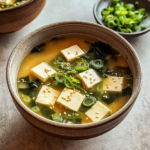Jump to:
Easy Homemade Miso Soup Tofu Recipe
Miso soup tofu is a comforting Japanese dish that brings warmth and nourishment to any meal. This traditional recipe combines the umami-rich flavor of fermented soybean paste with silky cubes of tofu, creating a satisfying soup that’s both simple to make and incredibly delicious. Perfect for beginners and seasoned cooks alike, this homemade version delivers authentic taste in just 25 minutes.
Why You'll Love This Recipe
- Quick and easy preparation that takes only 25 minutes from start to finish, making it perfect for busy weeknight dinners
- Packed with plant-based protein from tofu and probiotics from miso paste, supporting your digestive health and overall wellness
- Budget-friendly ingredients that are readily available at most grocery stores, making this an economical meal option
- Versatile base recipe that can be customized with your favorite vegetables, mushrooms, or noodles for endless variations
- Authentic Japanese flavors that transport you to a cozy Tokyo restaurant without leaving your kitchen
Why This Miso Soup Tofu Recipe Works
This recipe succeeds because it respects traditional Japanese cooking methods while remaining accessible to home cooks. The key lies in properly dissolving the miso paste to avoid lumps and maintaining a gentle simmer to preserve the tofu’s delicate texture.
The combination of dashi broth and miso creates a complex umami foundation that perfectly complements the mild tofu. By adding ingredients in the correct order, each element maintains its distinct character while contributing to the harmonious whole.
The wakame seaweed adds authentic oceanic notes and valuable minerals, while green onions provide a fresh contrast to the rich, savory base. This balance of flavors and textures makes every spoonful satisfying and nourishing.

What You’ll Need for Perfect Miso Soup Tofu
Ingredients
| Ingredient | Quantity (Approx) | Purpose / Notes |
|---|---|---|
| Water or dashi broth | 4 cups | Base liquid for umami depth |
| Miso paste | 3 tablespoons | Main flavor component, use red or white |
| Firm tofu | 1 cup, cubed | Protein source and texture contrast |
| Fresh green onions | ½ cup, sliced | Fresh garnish and mild onion flavor |
| Dried wakame seaweed | ¼ cup | Authentic texture and mineral content |
| Low-sodium soy sauce | 2 teaspoons | Additional umami and salt balance |
Tools
| Tool | Purpose |
|---|---|
| Large pot | Main cooking vessel for simmering soup |
| Small mixing bowl | Dissolving miso paste smoothly |
| Whisk | Incorporating miso without lumps |
| Ladle | Transferring hot broth for miso mixing |
| Sharp knife | Cutting tofu and green onions precisely |
How to Make Easy Homemade Miso Soup Tofu
| Step | Instructions |
|---|---|
| Step 1: Prepare the base | In a large pot over medium heat, bring water or dashi broth to a gentle simmer. Avoid boiling vigorously to maintain delicate flavors. |
| Step 2: Add seaweed | Add dried wakame seaweed and let it rehydrate for about 5 minutes. The seaweed will expand and soften considerably. |
| Step 3: Dissolve miso | In a small bowl, mix miso paste with a ladleful of hot broth until dissolved. Whisk this mixture into the pot to prevent lumps. |
| Step 4: Add tofu | Gently add cubed tofu and heat for 2-3 minutes without stirring too vigorously. This prevents the tofu from breaking apart. |
| Step 5: Final seasoning | Stir in soy sauce and season with salt if needed. Garnish with sliced green onions before serving immediately. |
| Step 6: Serve | Serve hot in individual bowls and enjoy while the soup is at its optimal temperature and flavor. |
Chef's Helpful Tips
- Never add miso paste directly to boiling soup as high temperatures can destroy beneficial probiotics and create an unpleasant grainy texture
- Choose firm or extra-firm tofu for better shape retention, and pat it dry before cubing to prevent excess water in your soup
- Make fresh dashi using kombu and bonito flakes for superior flavor, or use high-quality instant dashi powder as a convenient alternative
- Store leftover miso paste in the refrigerator where it will keep for months, and always use a clean spoon to prevent contamination
- Taste your soup before adding salt since both miso paste and soy sauce contribute significant sodium to the final dish
Serving and Storage Tips for Miso Soup Tofu
Serving Tips
Serve miso soup tofu immediately while hot for the best flavor experience. Traditional Japanese presentation uses small individual bowls that retain heat well. Pair this soup with steamed rice, grilled fish, or vegetables for a complete meal.
Consider serving alongside dishes like Ultimate Chicken Casserole for a fusion dinner experience. The soup also works beautifully as a starter before heavier main courses.
For storage, refrigerate leftovers for up to 3 days. Reheat gently over low heat, avoiding boiling which can make the tofu tough. The soup may separate slightly when stored, but gentle stirring will restore its consistency.

Mistakes to Avoid while making Miso Soup Tofu
Don’t boil the soup vigorously after adding miso paste, as excessive heat destroys the delicate flavor compounds and beneficial probiotics. Keep the temperature at a gentle simmer throughout the cooking process.
Avoid adding miso paste directly to the pot without first dissolving it in warm broth. This common mistake creates lumps that won’t dissolve properly and affects the soup’s smooth texture.
Never use soft or silken tofu unless you prefer a more delicate, easily broken texture. Firm tofu maintains its shape better and provides more satisfying bite contrast to the liquid soup.
Don’t oversalt the soup initially. Both miso paste and soy sauce contain significant sodium, so taste before adding any additional salt to prevent an overly salty result.
You Must Know
- Miso paste varieties range from sweet white miso to robust red miso, each providing different flavor profiles that dramatically change your soup’s character
- Fresh tofu should be used within a few days of opening and stored in water that’s changed daily to maintain optimal texture and flavor
- Wakame seaweed expands significantly when rehydrated, so start with small amounts to avoid overwhelming your soup with sea vegetables
- Quality dashi makes an enormous difference in authentic flavor, so invest in good kombu and bonito flakes or premium instant dashi powder
Suggestions for Miso Soup Tofu Variations
Add sliced mushrooms like shiitake or enoki for extra umami depth and meaty texture. These fungi complement the soup’s earthy flavors while providing additional nutritional benefits and visual appeal.
Include thinly sliced vegetables such as carrots, daikon radish, or spinach for color and nutrients. Add harder vegetables early in cooking and leafy greens just before serving to maintain their vibrant appearance.
Try different miso varieties like mixed miso or specialty regional types for unique flavor profiles. Each type brings distinct characteristics that can transform your soup’s personality completely.
Consider protein additions like cooked chicken, shrimp, or fish for heartier versions. These work especially well when combined with recipes like Creamy Garlic Shrimp Pasta for surf-and-turf themed dinners.
For inspiration on traditional techniques, check out Serious Eats’ comprehensive miso soup guide or explore NYT Cooking’s authentic approach.

FAQs:
While best served fresh, you can prepare miso soup tofu up to 3 days ahead. Store in the refrigerator and reheat gently over low heat. The tofu may absorb some broth flavors, which many people actually prefer.
White miso is sweeter and milder with a shorter fermentation time, while red miso offers deeper, more complex flavors from longer fermentation. Both work excellently in this recipe depending on your taste preference.
Yes, you can use other seaweeds like kombu or nori, or omit it entirely. However, wakame provides authentic texture and mineral content that enhances the traditional flavor profile significantly.
Use firm or extra-firm tofu, add it gently to the pot, and avoid vigorous stirring. Let the tofu heat through naturally without aggressive mixing to maintain its cube shape.
Absolutely! Fresh dashi made from kombu and bonito flakes provides superior flavor depth compared to instant versions. However, high-quality instant dashi powder offers convenience with good results for busy weeknight cooking.
Conclusion
This easy homemade miso soup tofu recipe delivers authentic Japanese flavors with minimal effort and maximum satisfaction. The combination of umami-rich miso, silky tofu, and aromatic garnishes creates a nourishing soup perfect for any occasion.
Whether you’re seeking comfort food, exploring Japanese cuisine, or simply wanting a healthy, protein-rich meal, this recipe provides everything you need. The versatile base accommodates endless variations while maintaining its traditional character.
Start making this miso soup tofu today and discover why this simple yet sophisticated dish has remained a Japanese staple for centuries. Your kitchen will smell amazing, and your taste buds will thank you for this delicious, wholesome creation.
More Easy Dinner Recipes:
- Easy Chicken Shawarma Recipe
- Delectable Chickpea Salad with Crunchy Pita Chips Delight
- Cheesy Stuffed Meatloaf Bites – Easy Party Appetizer Recipe
- Slow Cooker Dinner: Easy, Flavorful, and Time-Saving Meals
Recommended
📖 Recipe Card

Miso Soup Tofu
- Total Time: 25 minutes
- Yield: 4 servings 1x
Description
A traditional Japanese miso soup with silky tofu, wakame seaweed, and fresh green onions. This comforting and nutritious soup is perfect as a starter or light meal, featuring authentic umami flavors and beneficial probiotics.
Ingredients
- 4 cups water or dashi broth
- 3 tablespoons miso paste
- 1 cup firm tofu, cubed
- ½ cup fresh green onions, sliced
- ¼ cup dried wakame seaweed
- 2 teaspoons low-sodium soy sauce
Instructions
- Step 1: Prepare the base – In a large pot over medium heat, bring water or dashi broth to a gentle simmer. Avoid boiling vigorously to maintain delicate flavors.
- Step 2: Add seaweed – Add dried wakame seaweed and let it rehydrate for about 5 minutes. The seaweed will expand and soften considerably.
- Step 3: Dissolve miso – In a small bowl, mix miso paste with a ladleful of hot broth until dissolved. Whisk this mixture into the pot to prevent lumps.
- Step 4: Add tofu – Gently add cubed tofu and heat for 2-3 minutes without stirring too vigorously. This prevents the tofu from breaking apart.
- Step 5: Final seasoning – Stir in soy sauce and season with salt if needed. Garnish with sliced green onions before serving immediately.
- Step 6: Serve – Serve hot in individual bowls and enjoy while the soup is at its optimal temperature and flavor.
Notes
- Never add miso paste directly to boiling soup as high temperatures can destroy beneficial probiotics and create an unpleasant grainy texture.
- Choose firm or extra-firm tofu for better shape retention, and pat it dry before cubing to prevent excess water in your soup.
- Make fresh dashi using kombu and bonito flakes for superior flavor, or use high-quality instant dashi powder as a convenient alternative.
- Taste your soup before adding salt since both miso paste and soy sauce contribute significant sodium to the final dish.
- Prep Time: 10 minutes
- Cook Time: 15 minutes
- Category: Soup
- Method: Simmering
- Cuisine: Japanese
Nutrition
- Serving Size: 1 serving
- Calories: 85 calories
- Sugar: 3g
- Sodium: 890mg
- Fat: 4g
- Saturated Fat: 1g
- Unsaturated Fat: 3g
- Trans Fat: 0g
- Carbohydrates: 8g
- Fiber: 2g
- Protein: 7g
- Cholesterol: 0mg
Keywords: miso soup tofu, Japanese soup, umami, wakame seaweed, healthy soup, vegetarian, probiotics









